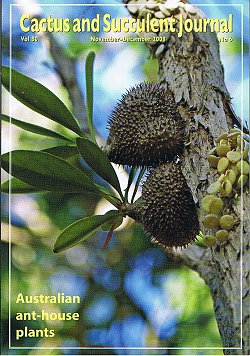

| CSSA VOL.80, November-December 2008 No.6 |
|---|
| Weird and wonderful ant-house plants | Attila Kapitany |
| Camelhair brush confidential : Propagation of the cliff dwelling Madagascan Begonia goudotii | Daniel M Houston, Gary James & Joseph M Stead |
| Some succulent memories: Part 7 .The ISI | Myron Kimnach |
| Agave utahensis Jewel of the Genus | Zlatko Janeba |
| Cactus tips from a master grower Astrophytum | Elton Roberts |
| Stalking the wild Lophophora Part 3. San Luis Potosi (central), Querétaro and Mexico City | Martin Terry |
| Book Review : The Genus Echeveria by John Pilbeam | Brian Kemble |
| Succulent and xeromorphic bromeliads of Brazil Part 4. Dyckia richardii and D.grandidentata two new succulent and heavily armed species from west-central Barzil | Pierre J Braun & Eddie Esteves Pereira |
| Succulents on Stamps: Christmas | Peg Spaete |
|  |
On the cover Attila Kapitany found these spiny specimens of Myrmecodia beccarii clinging to a Coastal Paperbark tree in Port Douglas, Queensland, Australia. At approximately 9 cm in diameter they have yet to reach maturity-usually marked by a decrease in spines on the expanding tuber. Once tiny pores open along the outside of the caudex, ants will occupy the labyrinth of tunnels within and vigilantly defend the plant from harm. Mature old plants can reach 25 cm in diameter and become so heavy that they are commonly dislodged from trees during storms. Cyclones in this region occasionally strip trees bare of epiphytes, which then lie on the ground and rot.
The yellow-leaved vine growing nearby, Dischidia nummularia, is also succulent. Because it is common in myrmecodia habitats, and easy to see, it's a useful indicator in the ant-plant hunt-aside from being a popular horticultural subject in its own right.
These bizarre and mostly Australian succulents feature prominently in Attila's latest book, Australian Succulent Plants. |
|



